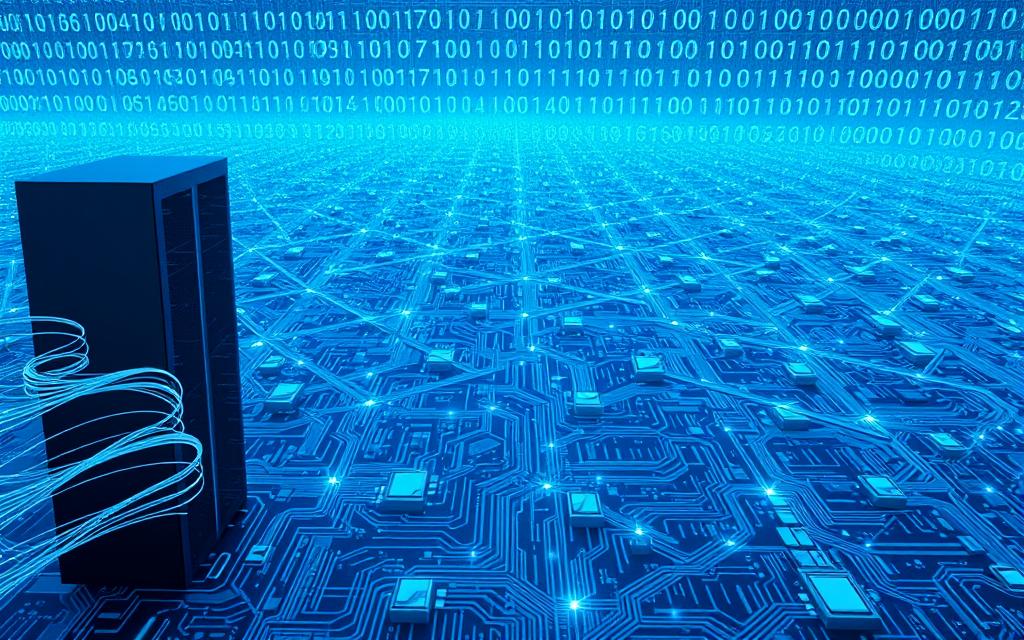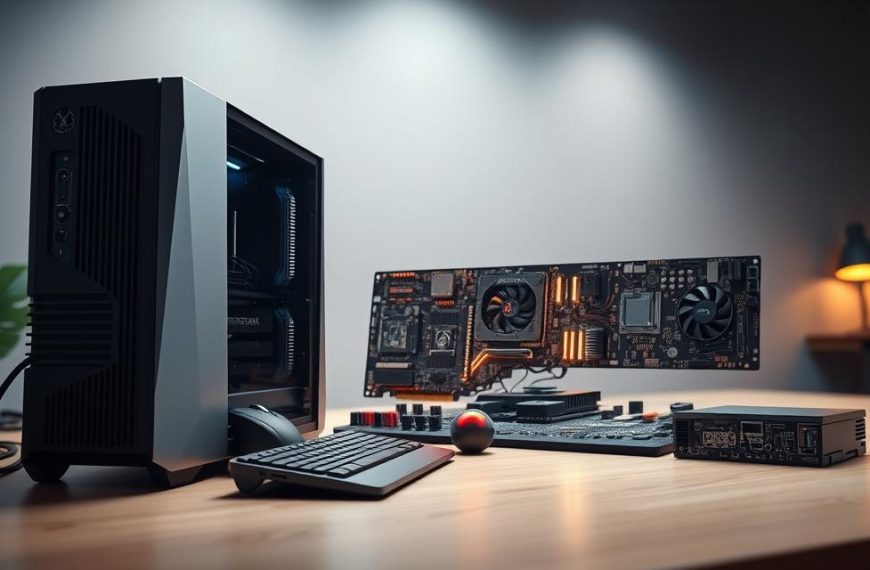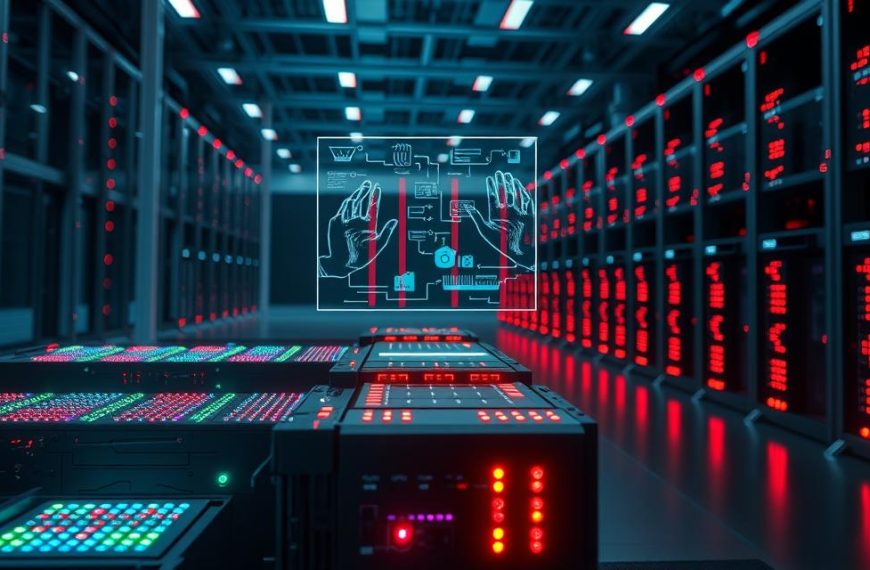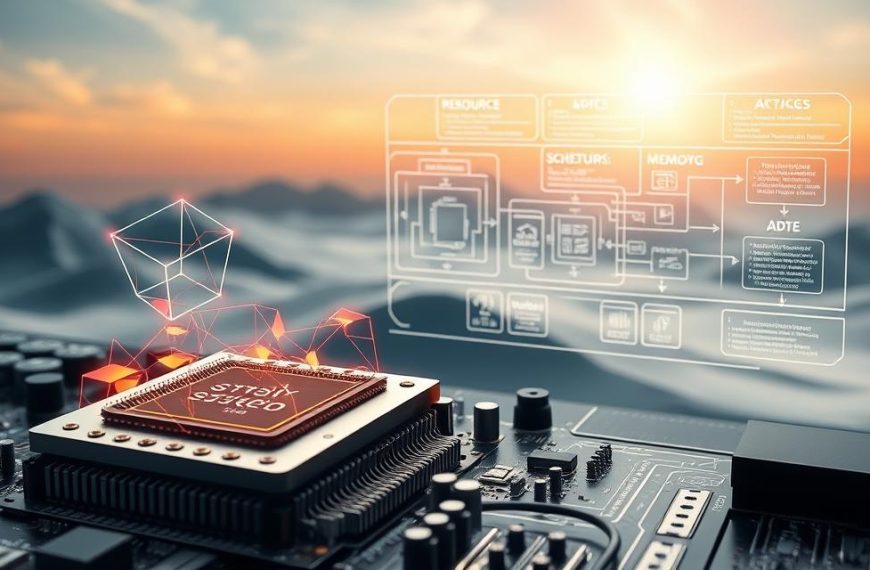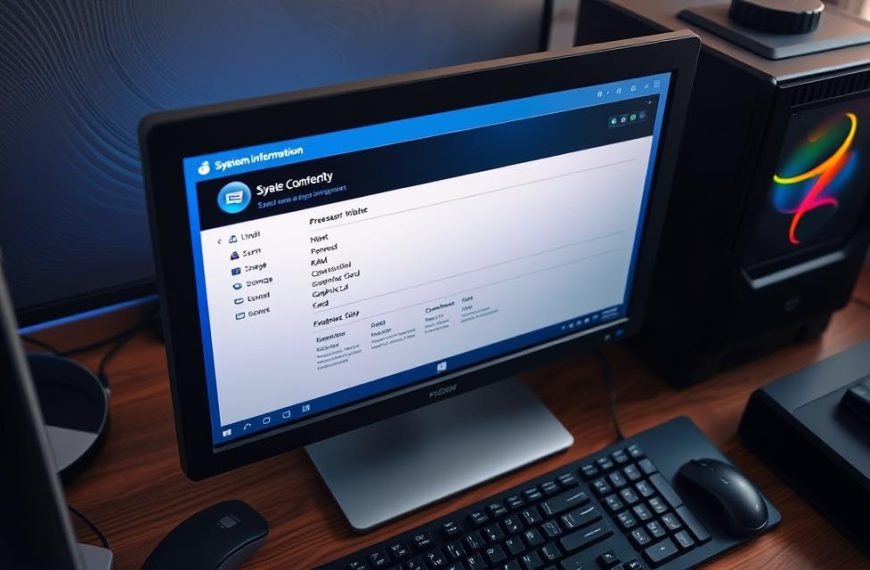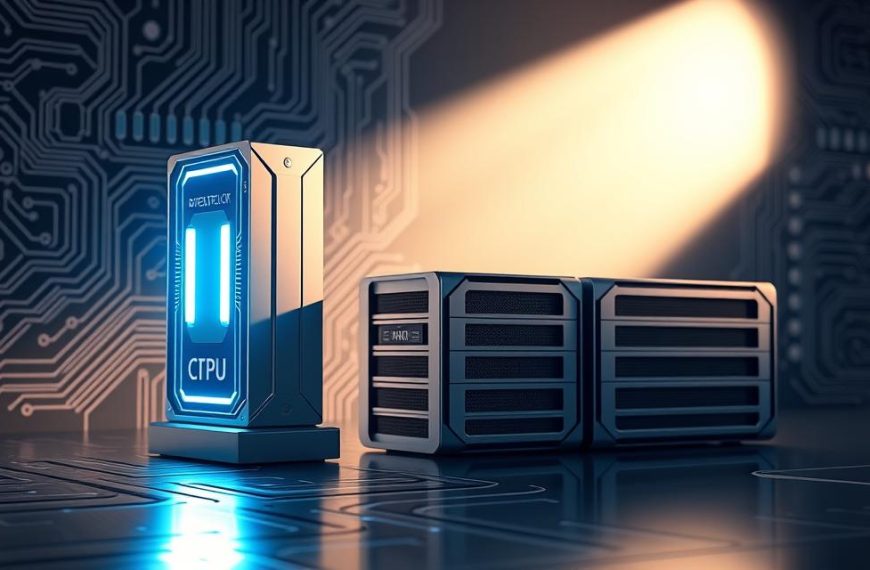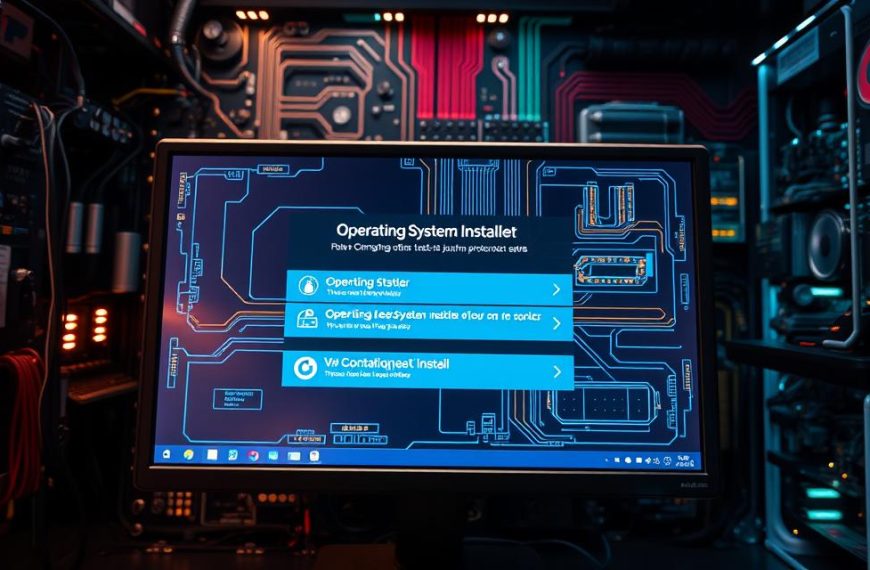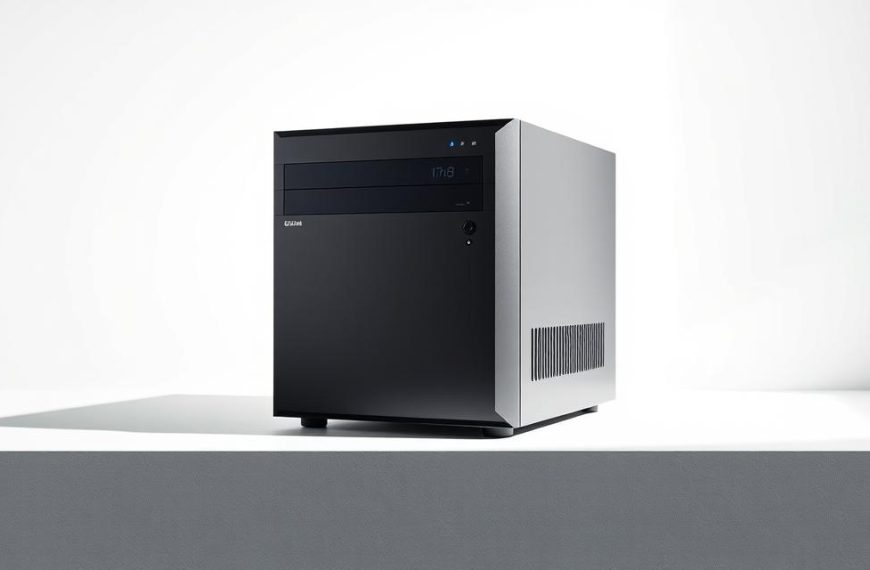Every digital device has a basic language that makes it work. This language uses only two numbers: 0 and 1. These numbers are the foundation of all computer tasks.
Modern devices use tiny switches called transistors. These switches can only be on or off. This makes the binary system the best choice for computers.
Programmers use languages like JavaScript, but all code turns into machine instructions. Knowing how this works helps us understand how computers work at their core.
Learning about binary is key for tech enthusiasts. It shows the beauty in how computers handle complex tasks and store data.
The Fundamental Nature of Binary Systems
Before we dive into why computers use binary, let’s grasp its basics and history. The binary system is the core language of computing. It’s the base for all digital tech.
What Exactly is the Binary Number System?
The binary system is a base-2 system, using only 0 and 1. Unlike our decimal system with ten digits, binary’s simplicity is perfect for electronics. Each binary digit represents a power of two, starting with 2⁰ on the right.
Just like decimal, binary uses place-value notation but with powers of two. For example, 1011 in binary equals:
- 1 × 2³ = 8
- 0 × 2² = 0
- 1 × 2¹ = 2
- 1 × 2⁰ = 1
Adding these, we get 8 + 0 + 2 + 1 = 11 in decimal. This shows how binary efficiently represents values.
Historical Origins of Binary Representation
Gottfried Wilhelm Leibniz formalised the binary system in the 17th century. He’s known as “The Father of Binary Code.” Leibniz saw the beauty of base-2 arithmetic and its ability to simplify complex ideas.
Before Leibniz, Francis Bacon had a bilateral cipher in the 16th century. It used letter pairs (A/B) like 0/1. This early binary showed its power in information encoding.
These early works set the stage for modern computing. The shift from idea to practical use changed how we handle information.
| Historical Figure | Contribution | Time Period | Significance |
|---|---|---|---|
| Francis Bacon | Bilateral cipher using A/B | 16th Century | Early binary-like encoding system |
| Gottfried Wilhelm Leibniz | Formal binary number system | 17th Century | Established mathematical foundation |
| Modern Computing Pioneers | Electronic implementation | 20th Century | Practical application in technology |
The journey from idea to practical tool is key in tech history. It’s the basis of our digital world today.
Why Do Computer Use Binary System: Technical Advantages
The binary system’s lasting popularity comes from its practical benefits. It’s the best choice for digital systems because of its technical advantages. This makes it efficient and reliable for computers.
The Physical Limitations of Electronic Components
Electronic parts work best with two states, making binary perfect for them. Transistors, key to modern computing, act as simple switches. They can be on or off.
This matches the binary system’s 1s and 0s. It makes designing and making electronic parts easier.
Unlike analogue systems, binary parts don’t need precise voltage checks. They just need to see if a signal is high or low. This makes them cheaper to make and faster to process.
Reliability and Error Reduction Advantages
The binary system’s simplicity boosts its reliability. With only two states, errors are much less likely than in systems with many voltage levels.
Signals can weaken or get mixed up, but binary’s high and low voltages stay clear. This makes sending binary data more reliable.
Binary also helps with finding and fixing errors. Simple checks can spot mistakes more easily than in complex systems.
These basic 0s and 1s are called bits. Eight bits together form a byte. Bytes are the basic units for computer data.
For example, ASCII uses specific byte patterns for letters and numbers. This binary base lets all digital devices share information reliably, no matter their hardware.
Boolean Logic: The Mathematical Foundation
Binary representation is the basic language of computing. But it’s Boolean logic that gives computers their reasoning skills. This framework turns simple 1s and 0s into powerful decision-making systems. These systems are at the heart of how computers think.
George Boole’s Contribution to Binary Systems
In the mid-19th century, English mathematician George Boole created a groundbreaking system of algebraic logic. This system, published in “The Laws of Thought” in 1854, is now key to computer science. It’s known as Boolean algebra.
Boole’s work was about reducing logical statements to simple algebraic expressions. He used only two values: true and false. This binary approach matches the on/off states of electronic computing. His system laid the mathematical foundation for processing logical operations in computers.
Boolean algebra works with three basic operations: AND, OR, and NOT. These operations use truth values to make logical conclusions. This creates a complete system for reasoning that computers can use. They can do this physically with transistors.
Basic Logic Gates and Their Functions
Logic gates are the physical form of Boolean operations in computer hardware. Each gate does a specific logical function based on its design and input signals. Modern computers have millions of transistors that make up these essential blocks.
The most basic logic gates include:
- AND gate: Outputs 1 only when all inputs are 1
- OR gate: Outputs 1 when at least one input is 1
- NOT gate: Outputs the opposite of its single input
- XOR gate: Outputs 1 when inputs differ
- NAND gate: Outputs 0 only when all inputs are 1
Each gate has a truth table that shows its output for every input combination. These tables fully describe the gate’s behaviour in binary terms.
Groups of transistors make up these logic gates. The way transistors are arranged determines the gate’s function. Different arrangements lead to different logical operations. This physical setup lets Boolean algebra become the active reasoning engine in computers.
By combining these basic gates, engineers can build complex circuits. These circuits can do everything from simple arithmetic to complex decision-making. All computer processing comes down to these fundamental logic gates made from transistors.
Hardware Implementation: From Transistors to Binary
The beauty of binary math comes to life in electronic components. This part looks at how 1s and 0s turn into real electrical signals in computers.
How Transistors Represent 1s and 0s
At the core of binary is the transistor, a tiny device that acts as an electronic switch. It has two states, matching binary digits perfectly.
With enough voltage, a transistor turns on, letting current flow. This is like the binary digit 1. Without enough voltage, it stays off, blocking current and representing 0.
This way of using transistors makes data very reliable. The clear difference between on and off means less chance of mistakes.
Many transistors work together to make logic gates. These are the basic parts of digital circuits. They do simple operations that computers use for everything.
The Clock Cycle and Binary Processing
Computers need everything to happen at the right time. A system clock provides regular pulses for this. Each pulse starts a new cycle of binary operations.
The clock makes sure everything works together. Processors follow the pulses, moving data around with perfect timing.
Understanding Clock Speed in Binary Operations
Clock speed, in hertz (Hz), shows how many operations a processor does per second. A 3 gigahertz processor does about three billion operations per second.
But faster processors use more power and get hotter. Modern designs try to balance speed with energy use.
Each cycle lets transistors switch, doing binary math through logic gates. This constant flow is what makes modern devices so powerful.
Memory Storage in Binary Format
Modern computing is efficient thanks to advanced memory systems. These systems turn 1s and 0s into real things in computers. Memory is where data waits to be used and is kept for later.
How Binary Data is Stored in Memory Cells
Computer memory is made up of tiny cells that hold binary data. Each cell can be a 0 or a 1. These cells group together to form bytes, with eight bits in each.
RAM uses special capacitors to store data. A charged capacitor is a 1, and an uncharged one is a 0. Hard drives use magnetic fields to store data in a similar way.
The ASCII system shows how bytes represent characters. For example, ‘A’ is 01000001 in binary. This makes data easy to understand on any computer.
Addressing and Retrieval Mechanisms
Memory systems use special addresses to find data. These addresses help the computer get data quickly and accurately. The memory controller turns these addresses into actions.
Getting data from memory is done without changing it. This keeps the data safe. Writing new data also uses special signals to change the memory cells.
Memory management uses Boolean logic to work better. It decides the best way to store and get data. This makes computers faster and more efficient.
Today’s memory systems also use caching. This is like a fast lane for data that’s used a lot. It makes computers run even faster while keeping data consistent.
Binary Arithmetic and Computational Operations
Computers use binary arithmetic, not decimal, for all calculations. This system breaks down complex tasks into simple steps that machines can handle quickly. Its beauty lies in being easy to understand and incredibly powerful.
Basic Binary Addition and Subtraction
Binary addition is like decimal but uses only two digits. There are four main scenarios when adding two bits:
- 0 + 0 = 0 (no carry)
- 0 + 1 = 1 (no carry)
- 1 + 0 = 1 (no carry)
- 1 + 1 = 10 (result 0 with carry 1)
Let’s add binary numbers 1011 (11 decimal) and 0110 (6 decimal). We start from the right, moving left with carry:
Subtraction works differently. Computers often use two’s complement for easy subtraction. This turns subtraction into addition, making it simpler for machines.
The carry mechanism is key for multi-digit operations. It’s the basis for all math in digital systems.
How Complex Calculations are Performed
Advanced math builds on basic binary arithmetic. For example, multiplication uses a method called shift-and-add, based on repeated addition.
Multiplication in binary follows a clear process:
- Generate partial products by multiplying each bit
- Shift these partial products left based on their position
- Add all the shifted partial products together
Division uses subtraction and shifting. These steps show how complex operations come from simple ones.
Floating-point operations add another layer of complexity. The IEEE 754 standard divides numbers into sign, exponent, and mantissa parts. This helps computers handle very large and small numbers well.
Modern processors have units called ALUs that do these operations fast. They use circuits that work in one clock cycle.
| Operation Type | Basic Method | Hardware Implementation | Typical Speed |
|---|---|---|---|
| Addition/Subtraction | Bit-wise with carry | Adder circuits | 1 clock cycle |
| Multiplication | Shift-and-add | Multiplier arrays | 2-4 clock cycles |
| Division | Successive subtraction | Divider units | 4-8 clock cycles |
| Floating-point | Normalised representation | FPUs | Varies by precision |
Binary arithmetic scales from simple to complex operations. All calculations boil down to organised binary steps.
The power of binary arithmetic drives computing progress. Knowing how it works shows the amazing abilities of today’s computers.
Beyond Basic Binary: Modern Extensions and Applications
Binary is the base of digital computing. But today, we have advanced systems that make things easier for us and machines. These new systems show how 1s and 0s have grown to power today’s tech world.
Hexadecimal and Other Numerical Representations
Working with long binary strings is hard for humans. So, we created shorter systems that are easy to read and work with.
Hexadecimal (base-16) is now the main way we write binary in computers. Each hex digit stands for four binary digits. This makes working with big binary numbers easier.
“Hexadecimal notation serves as the perfect bridge between machine language and human comprehension, reducing error rates in programming and system design.”
Converting binary to hex is simple. Take the binary number 11010111. Split it into groups of four bits (1101 and 0111). Then, each group becomes a hex digit: D and 7. This gives us D7 in hex.
Octal (base-8) is also used, mainly in old systems and some programming. These systems make binary data easier to see while keeping it mathematically correct.
| Numerical System | Base Value | Primary Application | Conversion Efficiency |
|---|---|---|---|
| Binary | 2 | Machine processing | N/A |
| Octal | 8 | Legacy systems | 3 bits per digit |
| Hexadecimal | 16 | Modern programming | 4 bits per digit |
| Decimal | 10 | Human computation | Complex conversion |
These systems are key in memory storage. They help in managing data and addresses in computers. Tools like debuggers and memory editors use these notations to show information.
Binary in Networking and Data Transmission
Binary is essential for communication between devices. It’s used in local networks and the global internet. Binary is the language of data exchange.
Network protocols turn all data into binary packets for sending. Each packet has binary header info and the data itself. This makes sure data gets to where it needs to go.
Telecom systems use binary for both wired and wireless signals. Fibre optic cables send binary as light pulses. Wireless networks use radio waves to send binary information.
Critical industries show how reliable binary is:
- Banking systems process transactions using binary-encoded data packets
- Healthcare networks transmit patient records and medical imagery
- Emergency services communicate through digital binary protocols
- Transportation systems manage logistics using binary data exchange
Error detection and correction add to binary’s role in transmission. Parity bits and checksums use binary to check data integrity. This is important for data that might get lost or changed during sending.
The efficiency of binary memory storage helps networking. Routers and switches need to store packets in memory. This lets them manage traffic and fix errors.
As networking gets faster and more reliable, binary’s role stays the same. New tech like 5G, fibre optic upgrades, and satellite internet all rely on binary.
Conclusion
Binary representation is key to modern computing, even with new tech coming up. It uses just ones and zeros, matching how electronic parts work. This makes data processing fast and reliable, better than other systems.
New tech like quantum computing might change things, but binary will stay at the heart of computing. It’s strong and will keep working well as tech gets better.
Binary data is hard for humans to read, but we have tools to help. Hexadecimal makes binary easier to work with in coding. ASCII turns binary into letters and symbols we can understand, making text work.
Knowing how binary works is vital for tech experts. It helps them understand how computers really work. This knowledge is key for anyone in tech.

